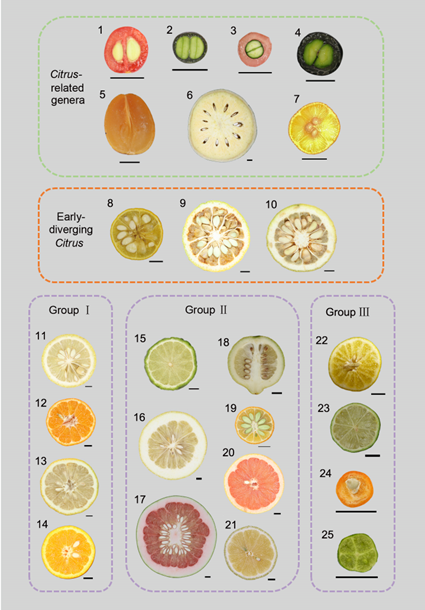
They reveal the origin and evolution of citrus and its relatives, and identify the key genes for fruit acidity.
Citrus is one of the most important fruit crops in the world, with a rich history and diversity. However, the origin and evolution of citrus have been controversial for a long time. Recently, a research team led by Professor Xu Qiang from the College of Horticulture and Forestry Sciences and the National Key Laboratory of Germplasm Innovation and Utilization of Horticultural Crops published a breakthrough study in Nature Genetics, shedding new light on the origin and evolution of citrus and its relatives.
The team analyzed the whole genome data of 312 citrus subfamily germplasm resources from around the world and reconstructed the phylogenetic relationship and evolutionary history of citrus and its relatives. They found that the ancient Indian plate, which collided with Eurasia about 50 million years ago, might be the origin center of the citrus subfamily. They also identified two secondary differentiation centers of citrus: one in the southeast foot of the Himalayas, where sweet orange, mandarin, pomelo, citron, and papeda diverged; and another in Australia and nearby islands, where Australian lime, finger lime, and kumquat diverged.
The team also drew the pan-genome map of the citrus subfamily, which revealed the genomic diversity and structural variation among different citrus species. They identified the key genes regulating citric acid accumulation in citrus fruits, which is an important trait affecting fruit quality and flavor. They found that some wild relatives of citrus had lost the sour taste due to mutations in these genes.

The team collected more than 300 citrus resources from southern China and other regions, including some wild and rare species. They visited ancient trees, interviewed old farmers, and tasted different fruits. They also collaborated with scientific researchers and fruit farmers from Yunnan, Hunan, and other places. They said that they were inspired by Academician Deng Xiuxin, who had led them to explore the southern citrus distribution areas many times.
The team’s research results have important implications for understanding the origin and evolution of citrus, as well as for improving citrus breeding and industry. The team hopes to continue their efforts to transform scientific research results into germplasm resources, and contribute to China’s seed industry security and rural revitalization.
The research team consists of Professor Xu Qiang, PhD students Huang Yue, Xu Yuantao, He Jiaxian, Zheng Weikang, and other members from our college. The research was supported by the National Natural Science Foundation of China, the National Key Research and Development Program of China, and other funding sources.
Source: HZAU News Network, Nature Genetics

